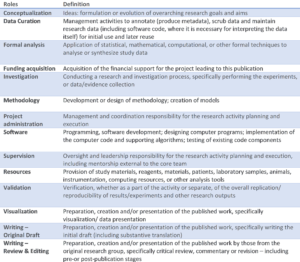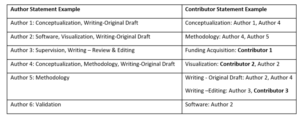Research activities have gradually become more collaborative and complex in the spirit of Open Science. As a result research outputs are more often produced by groups rather than individuals and increasingly multiple stakeholders are involved. While collaboration is becoming the norm, acknowledging the input of non-authors is usually limited to the classic acknowledgement section in a paper, book or report. Recent developments, such as the Data on open collaboration, are increasingly promoting this collaborative nature of research and recognition by being more open and transparent about it. As a result, the contributors to a research output can no longer stay in the dark!
But how do we capture and highlight research contributions? The Contributor Roles Taxonomy (CRediT) offers a solution!
CRediT is a clever way to better indicate every research contribution and acknowledge it in the research outputs. Instead of being listed as an author or being mentioned in the acknowledgement section, research contributions can be described in 14 roles identified in CRediT. As an example, a person can contribute to a project by securing the funding or organizing the data. Such contributions can be categorized as “Funding acquisition” or “Data curation”. This person can be acknowledged in any type of publication under a contributor statement with the role of “Funding acquisition” or “Data curation” next to their name. The table below gives an overview of all the contributor roles currently specified in CRediT.

CRediT does not only support transparency and Open Science but also contributes to research integrity and reduces conflict about contributions between authors. Hence it is only logical for the TU Delft OPEN Publishing to endorse this innovative way of acknowledging researchers’ contributions. We strongly encourage our research community and beyond to adopt CRediT. It increases visibility, stimulates collaboration and shifts the focus from the order of authors in a research publication to the entire realm of research contribution.
Interestingly CRediT supports the ambition of the Association of Universities in the Netherlands (VSNU) which aims to revise the current system of recognition and rewards of academics (see the VSNU position paper “Room for everyone’s talent”). The new system will acknowledge the independence and individual qualities and ambitions of academics as well as recognising team performances and efforts involved in open science. CRediT can contribute to this ambition as it makes it possible to acknowledge the specific contribution of an individual to the team performance.
The 14 contributor roles of CRediT will be integrated into the registry of ORCID and CrossRef. This will allow you to list your contributions in one place (ORCID) and increase the visibility of your contributions.
Thinking about implementing CRediT?
You can do it either as researchers or publishers. Check these recommendations or have a look at the example below. You can also easily capture contributions using the Tenzing app.

Contributor statement
Frédérique Belliard: Writing (Original draft & review)
Yan Wang: Writing (Original draft, review & editing), Resources
Esther Plomp: Writing (review & editing)
